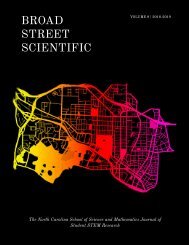Broad Street Scientific Journal 2020
Create successful ePaper yourself
Turn your PDF publications into a flip-book with our unique Google optimized e-Paper software.
Table 2. Significant 2-way ANOVA and Post-Hoc Test Results
2-way ANOVA
Region F value p-value Group Sig. Diff Tukey Comparison of Means p-value Greater Activation
ACC 4.158 0.018 HR-RO 0.013 HR
Left ACC 3.438 0.035 HR-RO 0.027 HR
Right ACC 4.328 0.015 HR-RO 0.011 HR
Left NAcc 4.4413 0.013 HR-RO 0.009 HR
by greater deactivation or less activation for RO subjects in
dorsal and ventral regions. While not significant, HR and
Control activation is greater than RO for all regions in the
Neutral condition. HR shows the greatest activation across
all regions except the Left DLPFC (control greater), while
controls show greater activation than RO in all regions.
In the Negative condition, there are no significant differences
between groups. HR shows greater activation in
all regions, while controls show greater activation than
RO in all regions but the Left DLPFC. Finally, to assess
the change in activation from the Neutral condition to
the Control condition, Neutral > Negative activation was
evaluated. While there were no significant differences between
groups, in dorsal regions except for the right DLP-
FC and the IPS, RO exhibited greater deactivation. This
deactivation can be attributed to RO having greater activation
in Negative conditions than Neutral conditions for
those regions.
3.5 - Brain Activity and Task Performance
We explored the impact of brain activity in working
memory and emotional processing regions on participants’
performance by the subject group during Neutral
and Negative conditions. For control participants, there
was a significant link between activation and task performance
in the Right NAcc in the Neutral condition.
This linear relationship (t=2.125, p=0.0429) is positively
correlated, with greater activation linked with a higher
D′ (Fig. 7). High-Risk participants showed a significant
negative correlation between activation and task performance
in the Left ACC (t=-2.312, p=0.034) and Left NAcc
(t=-3.086, p=0.007) for the Neutral condition and in the
Left NAcc (t=-2.876, p=0.011) , Right NAcc (t=-3.294,
p=0.005) , and Right Orbitofrontal Cortex (t=-2.486,
p=0.024) for the Negative condition. As presented in Figure
7, when brain activation increased for High-Risk participants
in the regions above, their D′ decreased, showing
worse task performance with increased activation. Recent
Onset participants exhibited a significant positive correlation
between brain activity and task performance in
the Left ACC (t=2.303, p=0.040) and Left Orbitofrontal
Cortex (t=2.225, p=0.046) during the Negative condition.
Both Control and Recent Onset participants showed a
strong positive correlation between brain activity and
task performance, while High-Risk participants showed a
strong negative correlation.
a) Neutral Condition
b) Negative Condition
c) Neutral > Negative Condition
Figure 6. Between Group Average Beta Values for
different conditions.
30 | 2019-2020 | Broad Street Scientific BIOLOGY




